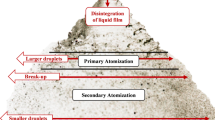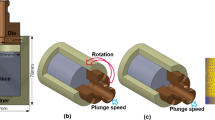Abstract
This article presents a detailed theoretical analysis of the selection of the maximum and minimum spray deposition rates under steady-state conditions during the spray-rolling process. The following predictions are made on the basis of the preceding theoretical analysis. First, the key factor that may control the minimum spray deposition rate is either the removal of porosity or the removal of prior droplet boundaries. With an increase in initial liquid fraction at the deposit/roll interfaces, the mechanism changes from the former to the latter. Second, the mechanism that controls the maximum spray deposition rate is related to either the drag-in angle or the distance between the nozzle and the deposited material’s surface. With an increase in roll diameter or a decrease in distance between the nozzle and the roll-axis plane, the controlling mechanism is changed from the former to the latter. Third, both the calculated maximum and minimum spray deposition rates markedly increase with an increase in roll diameter and roll rotational frequency. In addition, the present theoretical analysis suggests that spray rolling can be optimized to manufacture strips with a high production rate.
Similar content being viewed by others
References
I.J. Polmear: Light Alloys: Metallurgy of the Light Metals, Halsted Press, New York, NY, 1996, pp. 67–72.
R.E. Sanders, Jr.: JOM, 2001, vol. 53, pp. 21–25.
C.J. Petry and W. Szczypiorski: Light Met. Age, 1986, Aug., pp. 19–25.
B.Q. Li: JOM, 1995, vol. 47, pp. 13–17.
B.Q. Li: JOM, 1995, vol. 47, pp. 29–33.
K.M. McHugh, E.J. Lavernia, Y. Zhou, Y.J. Lin, J.-P. Delplanque, and S.B. Johnson: in Hot Deformation of Aluminum Alloys III, Z. Jin, A. Beaudoin, T. Bieler, and B. Radhakrishnan, eds., TMS, Warrendale, PA, 2003, pp. 443–52.
E.J. Lavernia and Y. Wu: Spray Atomization and Deposition, John Wiley & Sons, Inc., New York, NY, 1996, pp. 13–14 and 33–36.
K.M. McHugh: in P/M in Aerospace, Defense and Demanding Applications—1995, F.H. Froes, ed., Metal Powder Industries Federation, Princeton, NJ, 1995, pp. 345–53.
B.P. Bewlay and B. Cantor: J. Mater. Res., 1991, vol. 6, p. 1433.
D.D. Leon, R.L. Kozarek, and D.K. Denzer: in Liquid Metal Atomization: Fundamentals and Practice, K.P. Cooper, I.E. Anderson, S.D. Ridder, and F.S. Biancaniello, eds., TMS, Warrendale, PA, 2000, pp. 115–30.
K.M. McHugh: Idaho National Engineering and Environmental Laboratory, Idaho Falls, Idaho, unpublished research, 1999.
A.R.E. Singer: Metall. Mater., 1970, vol. 4, pp. 246–57.
Y. Saito, H. Utsunomiya, N. Tsuji, and T. Sakai: Acta Mater., 1999, vol. 47, pp. 579–83.
P.S. Grant: Progr. Mater. Sci., 1995, vol. 39, pp. 497–545.
Y.J. Lin, K.M. McHugh, Y. Zhou, and E.J. Lavernia: Metall. Mater. Trans. A, 2004, vol. 35A, pp. 3633–35.
J.N. Harris: Mechanical Working of Metals, Pergamon Press Ltd., Oxford, United Kingdom, 1983, pp. 112–14, 133–38, and 143–44.
R. Bland and H. Ford: Proc. Inst. Mech. Eng., 1948, vol. 159, p. 144.
Y.J. Lin, Y. Zhou, S.B. Johnson, J.-P. Delplanque, K.M. McHugh, and E.J. Lavernia: Proc. 2nd Int. Conf. on Spray Deposition and Melt Atomization and the 5th Int. Conf. on Spray Forming, Bremen, Germany, 2003.
M. Kiuchi: in Plasticity and Modern Metal-Forming Technology, T.Z. Blazynski, ed., Elsevier Science Publishers Ltd., Barking, Essex, United Kingdom, 1989, pp. 289–313.
R.L. Kozarek, M.G. Chu, and S.J. Pien: in Solidification 1998, S.P. Marsh, J.A. Dantzig, R. Trivedi, W. Hofmeister, M.G. Chu, E.J. Lavernia, and J.H. Chun, eds., TMS, Warrendale, PA, 1998, pp. 461–71.
S. Annavarapu and R. Doherty: Int. J. Powder Metall., 1993, vol. 29, pp. 331–43.
R.K. Dube and P.K. Bagdi: Metall. Trans. A, 1993, vol. 24A, pp. 1753–60.
Y.J. Lin, Y. Zhou, and E.J. Lavernia: J. Mater. Res., 2004, in press.
Y.J. Lin, Y. Zhou, and E.J. Lavernia: University of California, Davis, CA, unpublished research, 2004.
J.R. Davis: Aluminum and Aluminum Alloys, ASM INTERNATIONAL, Materials Park, OH, 1993, p. 676.
A.D. Sarkar: Friction and Wear, Academic Press Inc., New York, NY, 1980, p. 15.
Author information
Authors and Affiliations
Rights and permissions
About this article
Cite this article
Lin, Y., Zhou, Y., Lavernia, E.J. et al. The selection of the spray deposition rate during the spray rolling process. Metall Mater Trans A 35, 3595–3603 (2004). https://doi.org/10.1007/s11661-004-0195-4
Received:
Issue Date:
DOI: https://doi.org/10.1007/s11661-004-0195-4




